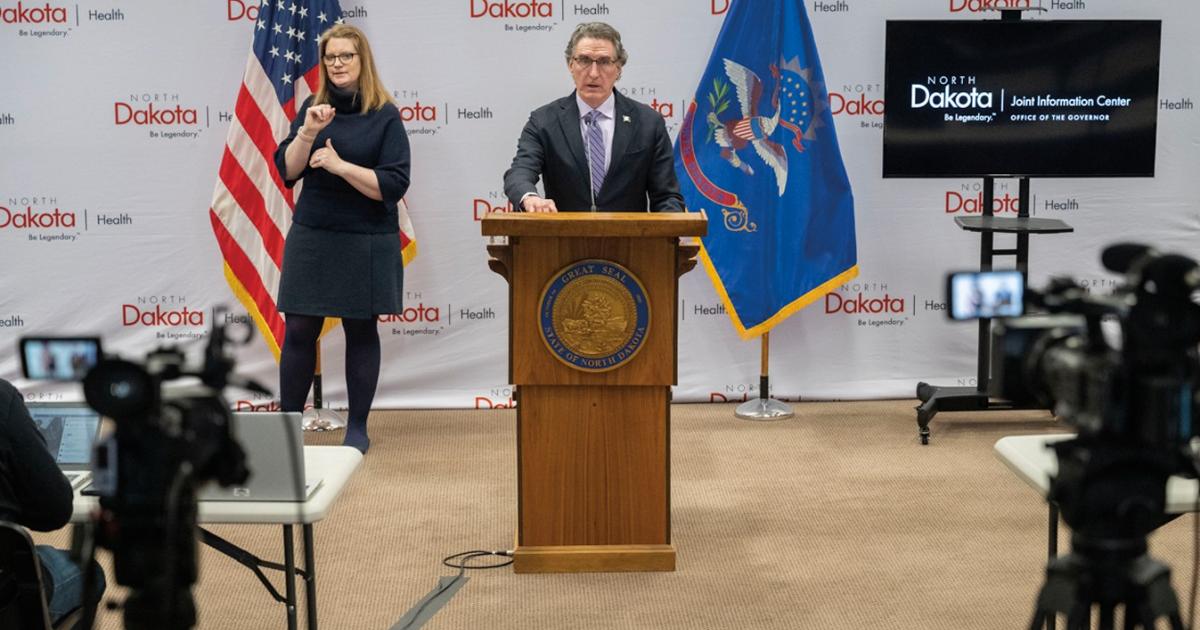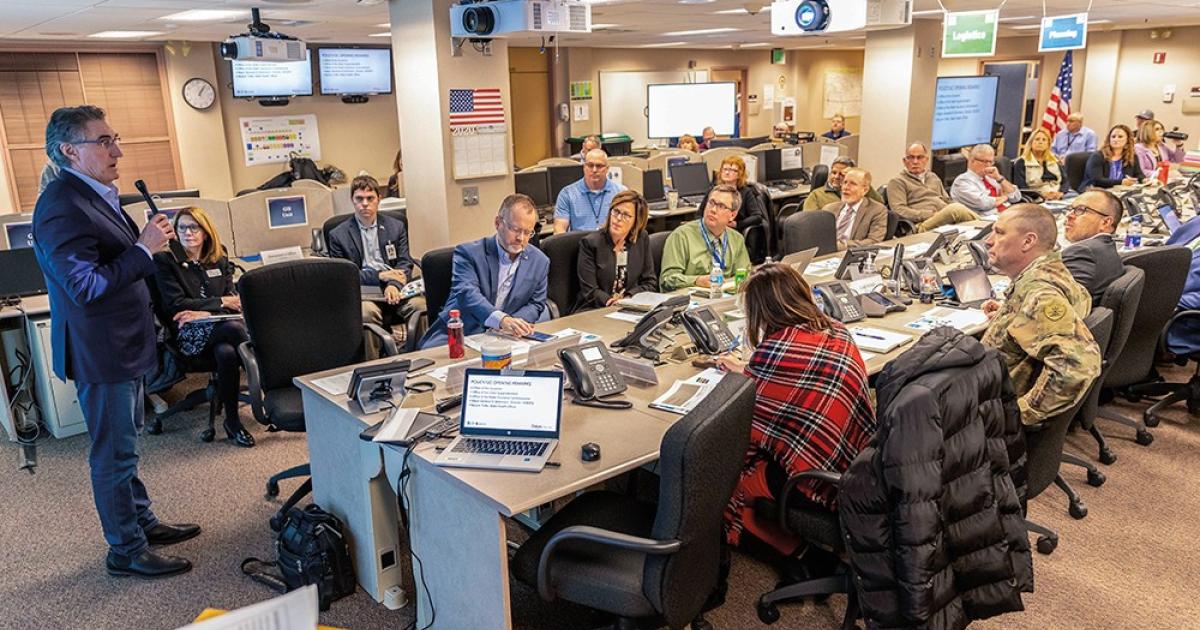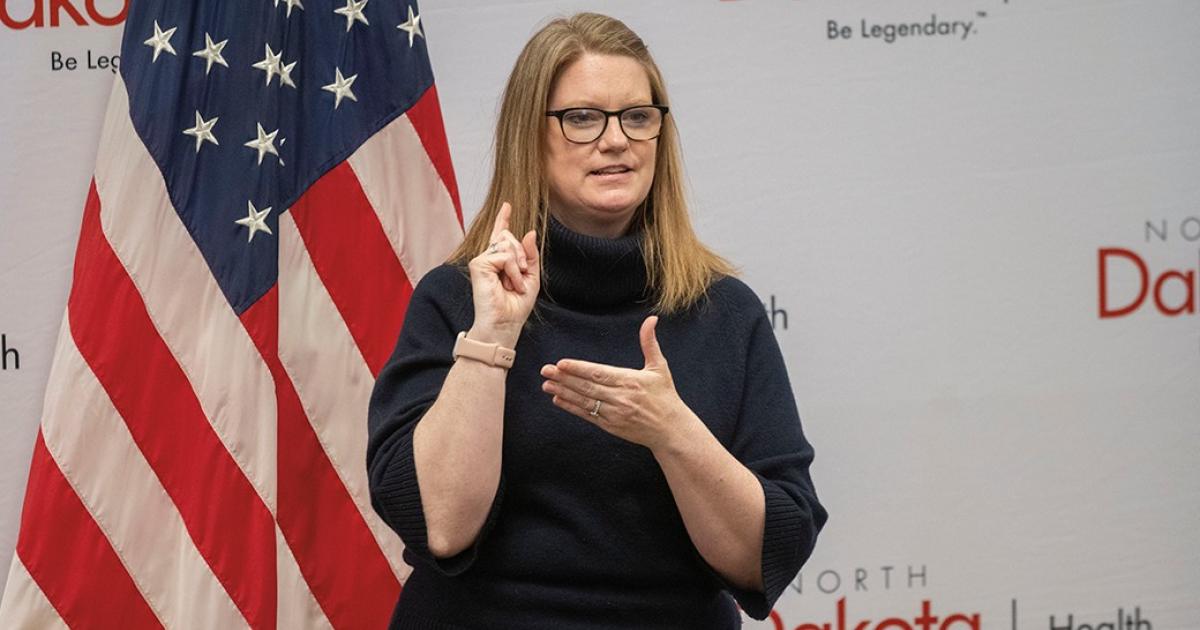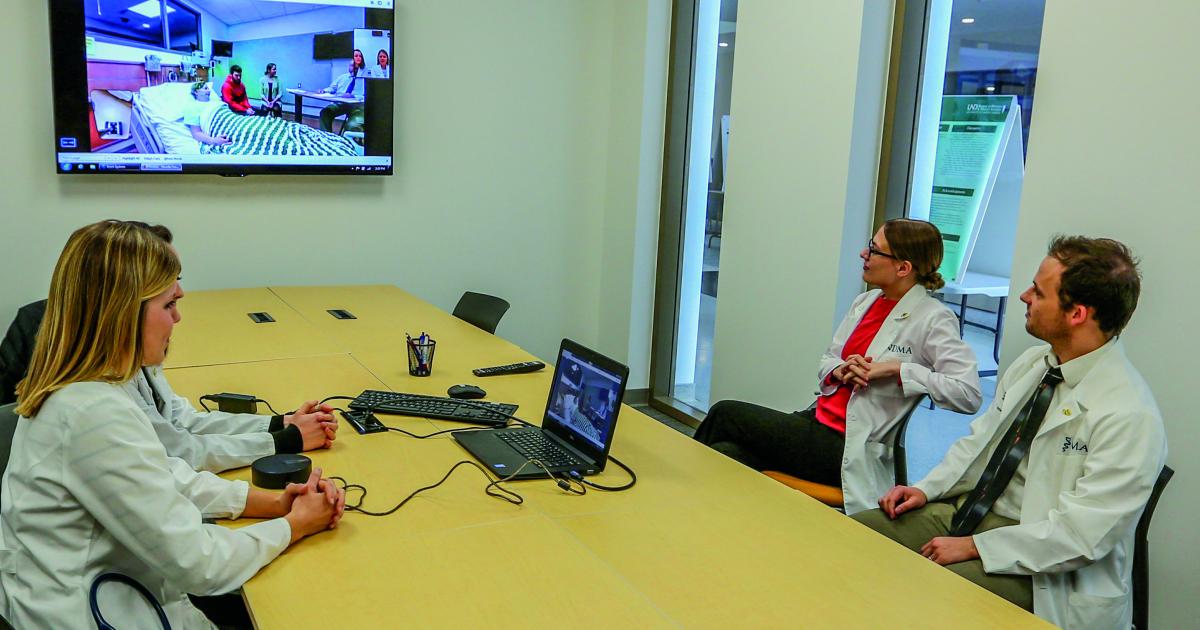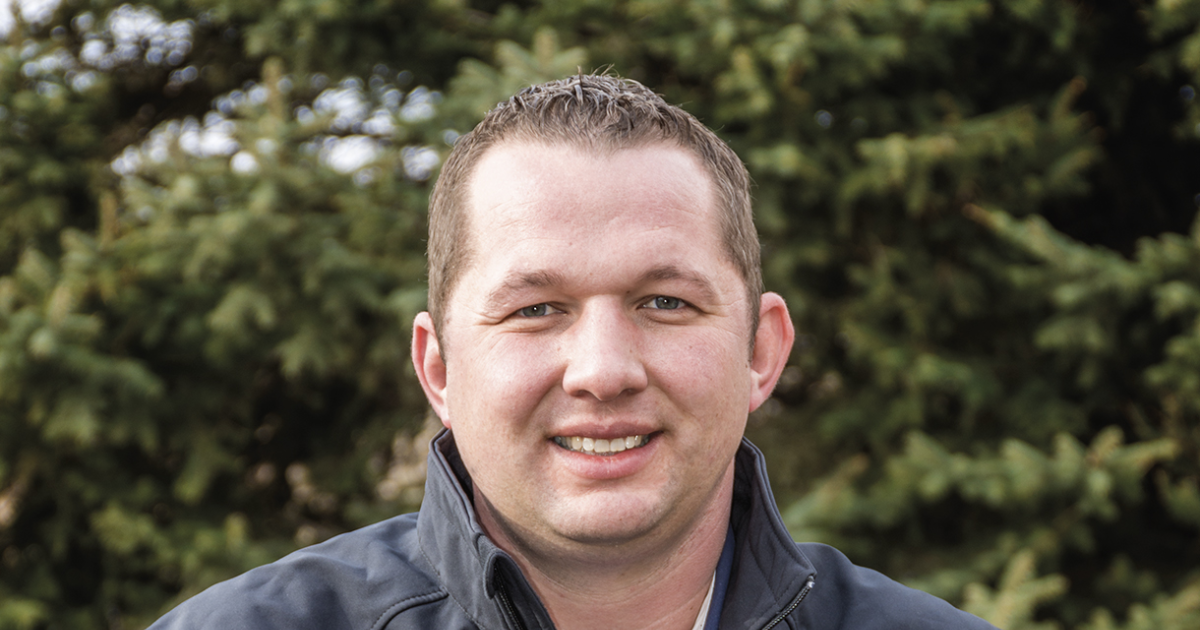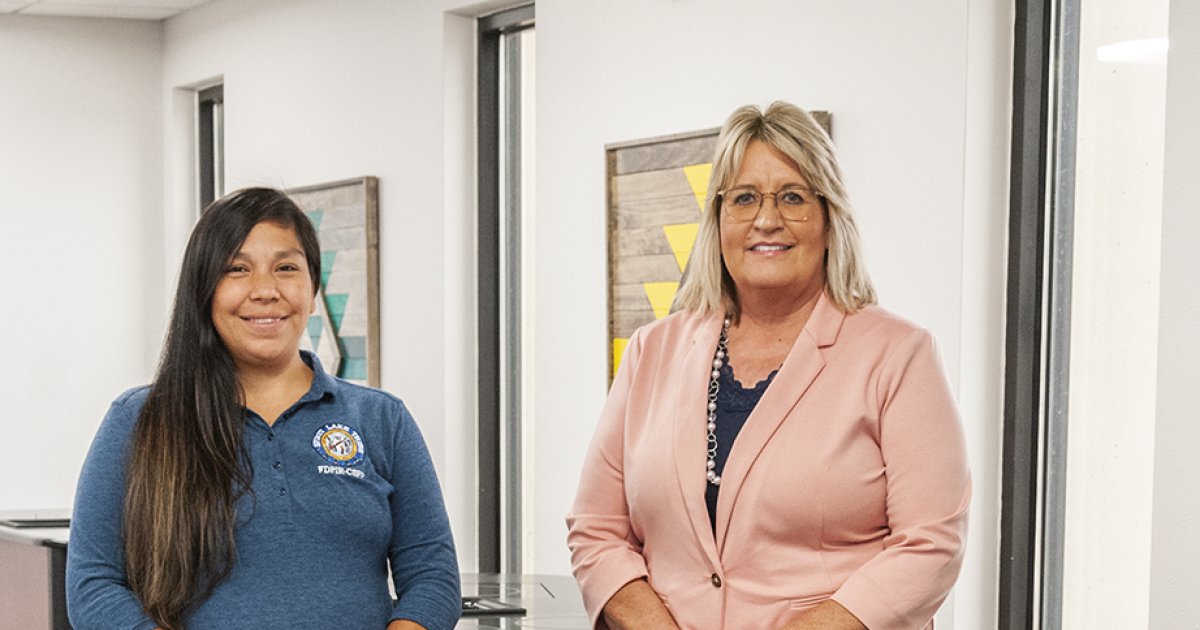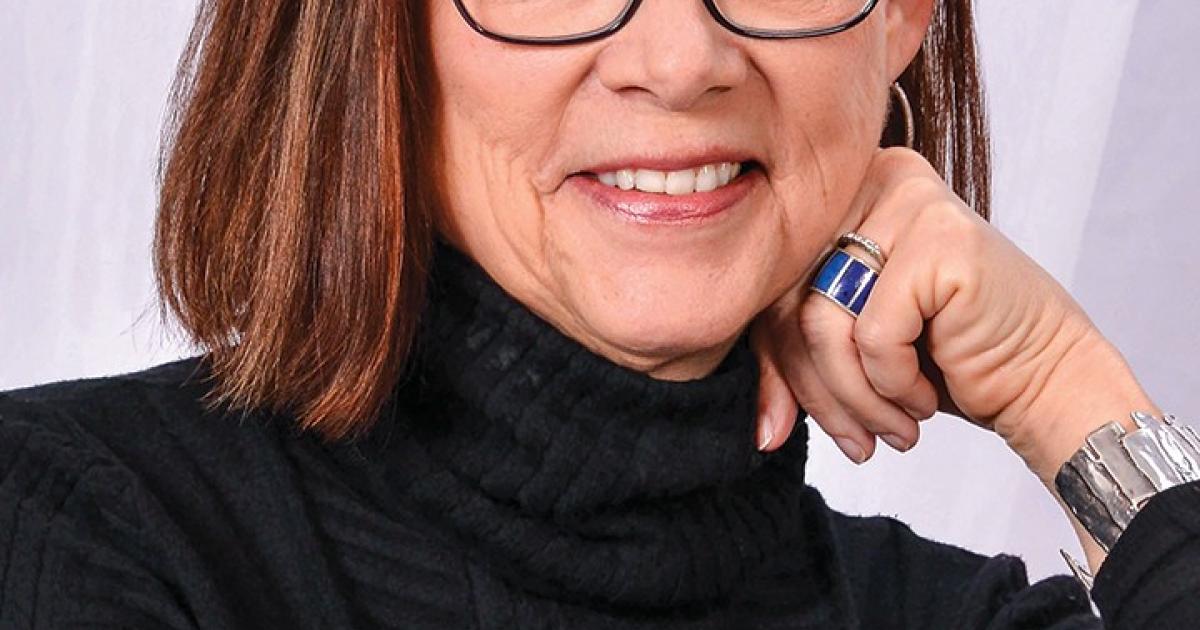Gov. Doug Burgum and his sign language interpreter. Name a more famous duo in North Dakota right now.
The pair have been photographed and videoed together since March 15, when Lindsey Solberg Herbel got a late Sunday call requesting her to sign for the governor’s press conference. Gov. Burgum announced temporary school closures for all North Dakota schools that evening, as part of a flatten-the-curve strategy in light of the coronavirus pandemic.
Most days since have included a standing press conference, where the governor, dressed in sport coat and tie, provides his daily COVID-19 update, and Herbel, in black, communicates that message to the state’s deaf population through sign language.
Lindsey Solberg Herbel signs for Gov. Doug Burgum during a COVID-19 press conference. Photo courtesy N.D. Department of Transportation
While their stories intersect today because of their jobs in a worldwide pandemic, there is clear distinction between the two. For him, it is governing and leading North Dakota through a big – uneasy and uncertain – moment in history. For her, it’s using this new platform (that she never asked for and certainly would give back) to create awareness and turn hearts toward inclusion.
Governing through a pandemic
Crisis management could be the emboldened phrase in Gov. Doug Burgum’s job description.
“It is certainly an interesting time to govern,” he says, reflecting on three-and-a-half years in office.
During his campaign, Burgum maintained we were in the middle of a financial crisis. Upon election, he secured a resolution to the Dakota Access Pipeline (DAPL) protests. Then, there were droughts and floods. And now, there is a worldwide pandemic.
“We’re in the middle of a storm and we’re going down whitewater and no one’s ever been down the river before,” Burgum says of this time. “Your heart and mind get stretched. It can be very unnerving to have all this uncertainty.”
How one reacts to such uncertainty can be telling. From Burgum’s observations, he sees what he’s been asking for all along: growth mindsets. A willingness to grow and change, as he describes it.
“I think this growth-mindset attitude that we’ve seen across so many agencies and so many individuals, everybody tackling new things, is really, really inspirational,” he says. “We have the opportunity to use this as a springboard to really reinvent and innovate, because from all this chaos, there’s an opportunity for transformation.”
HARD CALLS
One shining example is the relatively quick transition to distance learning. North Dakota schools were essentially given eight days to devise plans to complete the school year remotely and submit them by March 27 to the governor and his team, including the N.D. Department of Public Instruction. All 175 school districts met this requirement, with the help of the state’s 16,000 teachers. All 120,000 North Dakota school children were distance learning April 1.
The decisions to close schools and businesses were the hardest calls to make, Burgum says.
“In a world where I’ve been in business my whole life, having to do an executive order and asking people to close their businesses, that was really hard,” he says.
But by shutting down less than 7 percent of all North Dakota jobs, Burgum’s team believes that over 50 percent of transmissible moments of COVID-19 were eliminated. The 7 percent represents high-contact job categories, including salons, bars and restaurants.
And as schools retooled and restaurants offered new takeout or delivery options, many others changed their business models or asked employees to work from home.
“Organizations that operate silently and in the background have been thrust into huge challenges,” Burgum says, naming health care and long-term care facilities, disability service providers, corrections workers and those maintaining domestic violence or homeless shelters.
For these actions, Burgum has been quick to share his gratitude.
“So many people have been working so hard, and they’ve been doing that with amazing empathy and intelligence,” he says.
FOCUS
That includes Gov. Burgum himself, who has found this time to be very focusing. During his first year in office, over 1,700 requests came in for appearances at various events. Between the governor and Lt. Gov. Brent Sanford, they were able to oblige nearly one-third of those requests.
“From the time I graduated grad school until now, this was the longest stretch that I’ve known I’ve slept in the same bed in the same town,” he says.
With no travel logistics to manage or events on the schedule, the governor has had much-needed time to focus attention on health and economic issues during COVID-19.
“In some ways, it has been a very freeing and very focusing, highly productive time for the entire team, because it really allowed us to pour a lot of time and energy into solving the issues of the pandemic,” he says.
With continued human ingenuity and a global effort to battle against viruses in the future, Burgum sees a lot of good coming from this pandemic.
“If you think government can never change, we just have to look back at the last couple months,” he says. “We have shown that government can, across a lot of areas, be agile and be nimble and be quick. I get very excited about the future of North Dakota coming out the backside, particularly in terms of how we can reinvent government.”
SPIRIT
For the younger generation growing up during COVID-19, Gov. Burgum reflects on his mother, Katherine Kilbourne Burgum. Living through the Great Depression had a huge impact on her and the way she thought about life.
“It will be interesting to see how this changes a generation of younger people and how they think about their lives, how we responded and how we recovered,” he says.
While some things remain to be seen, to Burgum, North Dakota’s spirit is clearer than ever.
“This crisis has really revealed to the nation the character of North Dakotans,” he says. “We always knew that spirit of North Dakota is there, and sometimes that spirit really shines through.”
For all North Dakotans
Lindsey Solberg Herbel learned from an early age that people can communicate in different ways.
Grandma Doris was deaf. She wasn’t Herbel’s grandma, but a friend’s grandma and childhood babysitter. Growing up in Devils Lake, where the N.D. School for the Deaf is located, Herbel also learned a lot of sign language in school. Many of her friends were deaf students. There was a natural inclusion happening in her life.
But elsewhere, that wasn’t necessarily the case.
“We didn’t have students with disabilities in our elementary classrooms. It wasn’t until junior high and high school that deaf students were mainstreamed into our classes,” Herbel says. “There’s this feeling like we can only associate with people like us. There’s a lot of gray in this world. We’re often quick to judge.”
LEARNING
Through her relationships with deaf people and her 22-year career as a sign language interpreter, Herbel has learned a lot.
“In the field of interpreting, you really have to love learning,” she says.
She uses the example of a first-time assignment interpreting during an eye appointment. There is a whole new set of terms specific to eye care, and you may stumble some, but you learn from it. You reflect on your performance, do some research, and find ways to do better next time.
And she’s learned a lot about herself, too.
“Being in all these different environments and settings, I’ve learned what things I can emotionally handle,” she says. “You learn about yourself and what your limits are, what your values are.”
Imagine letting a stranger into some of your most intimate moments. Your annual physical. A loved one’s last moments lying in a hospital bed. Funerals. The deaf population that uses sign language lets others in and puts their trust in interpreters to communicate their thoughts.
“I’m grateful to the Deaf community, that they’re willing to share their language with us, and they trust us enough to let us into certain parts of their lives,” Herbel says. “We really work hard to build that trust, that we are going to be careful with that information.”
MATCHING THE MESSAGE
About 120 deaf North Dakotans use sign language, but they communicate in other ways, too, partly out of necessity.
“The deaf person has been working with hearing people their whole life,” Herbel points out.
Facial expression is part of American Sign Language (ASL), she explains. When you see her on the screen making those expressive faces or gestures, she is just doing her job.
“Whatever the mood is, maybe the governor is being firm that you have to stay home, (the interpreter has) to make sure the voice intonation matches the message,” she says.
Delivering the message clearly and effectively can become tiresome during the governor’s COVID-19 press conferences, but not how you may think.
“My brain gets tired before my arms do,” Herbel says. “When he starts reading, it’s incredibly difficult, because he’s reading as fast as he’s thinking.”
But just as with any assignment, Herbel puts in the work to improve each day. She watches other COVID-19 press conferences and studies other signers, finds better ways to communicate words or phrases, and always reads the governor’s talking points before going live.
INCLUSION
Herbel recognizes that her participation in press conferences is a good sign (no pun intended) that society is moving in the right direction.
“We’ve made tremendous gains toward inclusion,” she says. “Turn on the news and you see interpreters working. There’s captioning. We’ve come a long way, but there’s always more work to be done.”
“As interpreters, we’re privy to some of the discrimination that still might happen – things that aren’t necessarily noticeable to the hearing person,” she says. “We do see that, and promote education.”
It’s as easy as having a little patience when a deaf person pulls up in a drive-thru, or putting captioning on the monitors in your business, or simply having a piece of paper and pen ready to communicate through written word.
And if Herbel’s new gig as the governor’s interpreter has you interested in sign language, jump in and start learning. Herbel and Renae Bitner, a colleague at the N.D. School for the Deaf, are working on a series of five videos to teach some sign basics, with hopes of expanding the series in the future to utilize the talents of the Deaf community. Other resources are available through the N.D. School for the Deaf website.
Herbel admits that she likes wearing her mask, because this newfound recognition is uncomfortable. But if she’s given this platform, she’s going to use it as her hero, Mister Rogers, would advise. She asks herself, “How can I be a helper? How can I be a true friend?”
“I would like people to really step outside of their box,” she says. “Maybe there’s a kid in your class that has hearing aids, or an elderly neighbor stuck at home. Let’s find them and include them. Be a good neighbor.”
Cally Peterson is editor of North Dakota Living. She can be reached at cpeterson@ndarec.com.


